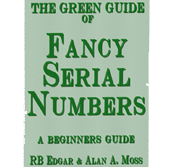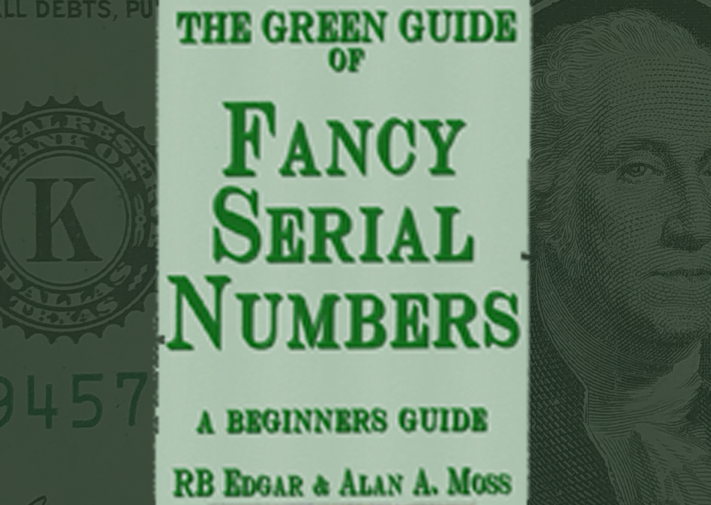CS-Radar.
Currency-Systems describes a radar as mirrored matched sets, M 1234 4321 M.
When reading from left to right, the first set of numbers are repeated in reverse
order in the second set, and sometimes the matched sets may share a digit, M
x4358534 M, as in the CS-Mini Radar 7. Another way to put it, is that the radar
portion of the serial number reads the same from left to right and from right to
left; they are palindromic.
CS-Palindrome.
CS-Palindromes are by definition a CS-Radar, as both are read the same from
left to right, as they are from right to left. CS-Palindromes and CS-Radars
are terms that are interchangeable and commonly used in the numismatic
community, but when it comes right down to it, the term CS-Radar is the term
used most often for FSNs.
CS-Super Radar.
A CS-Super Radar is a CS-Sextup within a CS-2OAK, M 04444440 M or
M 26666662 M.
CS-Full Radar.
A CS-Full Radar has all the matched numbers equidistant from each other, and
all eight positions in the serial number must have a match. The numbers must
read the same from left to right and from right to left, M 12344321 M, or
M 12433421 M or M 44122144 M.
CS-Bookend Full Radar.
A CS-Bookend Full Radar is a CS-Full Radar with CS-Bookends. Another way
to put it is that it is a CS-Full Radar with a CS-4OAK consisting of two CS-Pairs
at each end, M 44133144 M.
CS-Wide Radar.
A CS-Wide Radar, M 33322333 M, is a CS-6OAK with three of the CS-6OAK
grouped on the left side starting at position 1 and the other 3 grouped on the
right side starting at position 6 with a CS-Pair in the center starting at position 4.
CS-Split Six Radar.
A CS-Split Six Radar, M 66600666 M, is a CS-6OAK that is split into two
3OAKs separated by a CS-Pair of zeros.
CS-Quad Bookend Radar.
A CS-Quad Bookend Radar, M 22444422 M, is a CS-4OAK with two of the
CS-4OAK grouped on the left side starting at position 1 and the other two of the
CS-4OAK on the right side starting at position 7, with a CS-Quad in the middle
starting at position 3.
CS-Pinpoint Radar.
CS-Pinpoint Radar, M 41411414 M, is a CS-Binary and a CS-Radar. It consists
of two CS-4OAKs that are not paired except for the center. The center is the
only CS-Pair.
CS-Oscillating Radar.
CS-Oscillating Radar, M 44144144 M, is a CS-6OAK split into three CS-Pairs
separated by an equidistant CS-2OAK, and the CS-2OAK is in positions 3 and
6. This is also a CS-Tri Repeater.
CS-Shotgun Radar.
A CS-Shotgun Radar, M 123xx321 M or M x123321x M, is a CS-Radar
consisting of three CS-2OAKs (or one CS-2OAK and one CS-4OAK) that are
equidistant and located anywhere in the FSN. The other two digits are random
numbers that cannot be a CS-Pair.
CS-Lucky Seven Radar.
A CS-Lucky Seven Radar consists of a CS-Quint or CS-5OAK within a CS-
2OAK, and the # denotes the position of the random digit. Some CS-Lucky
Seven Radars can also be a CS-Quint in a Pair.
CS-Mini Radars.
CS-Mini Radars are not full eight digit CS-Radars. The smallest CS-Mini Radar
is three digits, M 212xxxx M, and the largest CS-Mini Radar is seven digits, M
4321234x M.
CS-Mini 3 Radar.
A CS-Mini 3 Radar is a CS-2OAK separated by only one random digit anywhere
in the FSN, M 1x1xxxxx M.
CS-Mini 4 Radar.
This is a CS-Pair is inside of a CS-2OAK grouped together, M 2442xxxx M or
M xx4224xx M.
CS-Mini 5 Radar.
A CS-Mini 5 Radar is a CS-2OAK separated by one digit with another CS-
2OAK directly outside the other one, M 24x42xxx M or M xx42x24x M. These
can also be a CS-4OAK, M 44x44xxx M, instead of two CS-2OAKs.
CS-Mini 6 Radar.
A CS-Mini 6 Radar is one CS-Pair surrounded by two equidistant CS-2OAKs,
M 234432xx M or M x221122x M or M xx121121 M.
CS-Mini 7 Radar.
A CS-Mini 7 Radar is three equidistant CS-2OAKs separated by one digit,
M x234x432 M.
999,999 1 $0
CS-Laddered Radars.
A CS-Laddered Radar is a CS-Full Radar with two CS-Mini Ladders inside
of the FSN. The CS-Mini Ladders can go up or down (ascending 1234 or
descending 8765). When the first four numbers are a CS-Mini Ladder and the
second set of four digits are a mirror image of the first four digits, then you have
a CS-Laddered Radar, M 9876 6789 M or M 1234 4321 M.
With CS-Laddered radars the way to tell the difference between a CS-Ascending
Laddered Radar and a CS-Descending Laddered Radar is the first four digits. Do
they go up or down? If they go up, M 1234xxxx M, then it is a CS-Ascending
Laddered Radar, and if they go down, M 6543xxxx M, then it is a CSDescending
CS-Ascending Laddered Radar.
CS-Ascending Laddered Radar M 45677654 M, the first digit can be a 0, 1, 2, 3,
4, 5, 6, or 7. The first four digits count up sequentially by one, and the second set
of four digits mirror the first four digits by counting down.
CS-Descending Laddered Radar.
CS-Descending Laddered Radar M 76544567 M, the first digit can be a 0, 9,
8, 7, 6, 5, 4, or 3. The first four digits count down sequentially by one, and the
second set of four digits mirror the first four digits by counting back up.
Note: This page contains excerpts and basic information from the book "The Green Guide to Fancy Serial Numbers". Please consider adding a copy to your library, thank you.





